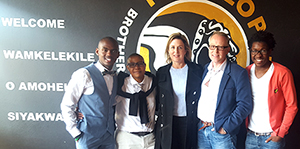
Tshepang Mahlatsi, Zane Thela, Dionne van
Reenen, Dr Thierry Luescher and Galeletsang
Soato, at the Brotherhood with no Limit panel
discussion held at Tswelopele residence on
the Bloemfontein Campus.
Photo: Supplied
Ignorance about issues relating to the Lesbian, Gay, Bisexual, Transgender, Queer and Intersex (LGBTQI) community is a threat to mankind. This is according to Tshepang Mahlatsi, former Prime of Tswelopele residence, regarding LGBTQI concerns at University of the Free State (UFS).
House Tswelopele on the Bloemfontein Campus hosted a panel discussion, Brotherhood with no Limit, on 19 September 2016 to discuss issues affecting the LGBTQI community, which has often been on the receiving end of criticism, hate speech and bigotry.
Academics take stance at LGBTQI discussion
The panel, which consisted of staff members and students, opened the discussion to everyone on campus. The panel comprised Zane Thela, Programme Coordinator: Gender and Sexual Equity Office: Student Affairs; Dionne van Reenen, Assistant Researcher; Dr Thierry Luescher, Assistant Director, Directorate for Institutional Research and Academic Planning, and Mahlatsi.
Creating a safer environment for LQBTQI dialogue
“The message that we were putting across was simple. We as a house cannot allow society to define our own brothers for us,” Mahlatsi said. The responsibility of students and student leaders was to stand in solidarity. He said it was not fair that in the 21st century people were still fighting to be recognised for who they were and what they identified themselves as. This issue had been discussed at Tswelopele before and it was not that much of an issue, Mahlatsi said. “However, this was the first formal one [discussion] where we had speakers who are more informed on the topic.”
The panel discussion also aimed to challenge other residences that still do not allow such talks to take place in a safe environment.